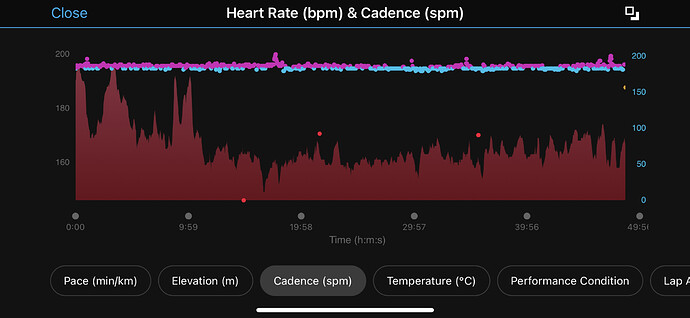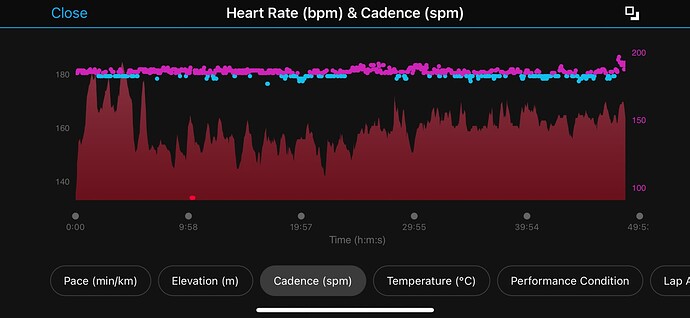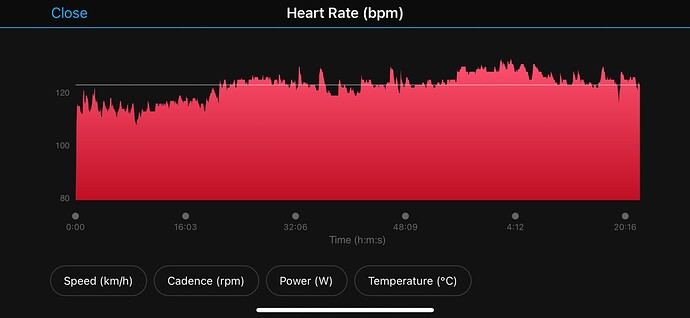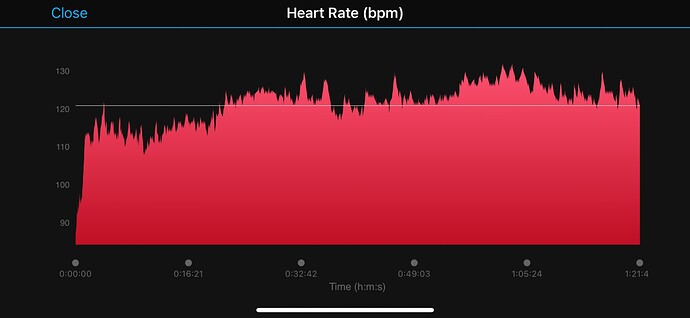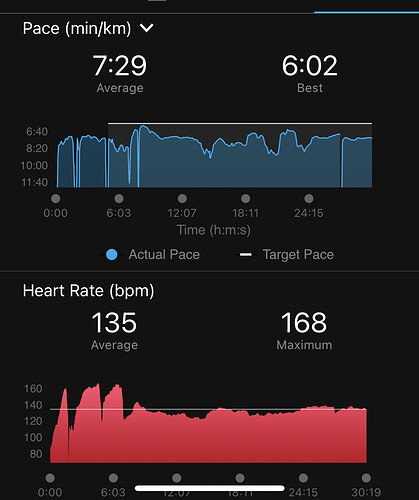Can you post the cadence graphs for the two problem situations too btw, it can often identify if it’s a simple cross over problem.
I’m not sure what we’re looking for here, but here you go. My run cadence at a solid pace is around 180.
Easy run, no elevated heart rate, ForeRunner 45S
London Olympic, unusual HR, Fenix 6S
Dartford Olympic, unusual HR, EDITED Fenix 6S
HOld On!
I may have it wrong. In my OP I originally posted that the second graph was from a sprint, then corrected it as it was from the Dartford Olympic - I did not wear a chest strap at the Dartford Olympic, I don’t think anyway. Apologies.
Unfortunately I didn’t record the bike at the sprint and started the run record late into the run (again) so that record isn’t useful.
I will ratify that this is the problem: “ will do a brick session tomorrow morning, and find a way to record both watch HR and chest based HR ”
If I delete the strap from my Fenix, and pair the strap to my forerunner we should have good data.
So your easy run was at 140 cadence, which is also the “no dodgy HR”, but of course you’d not call a 140 HR as dodgy in that context. But when you’re running hard, your cadence is 180 and that’s also your peak dodgy HR value, so cross over is possible.
The 8ish minute spike in the london olympic, you can see your cadence sped up at that point which could’ve helped trigger it, but the going up to only your cadence could be coincidental, obviously 180 is also likely to be your max HR here.
The essential problem is there’s two waves, one the change from the jiggling of you running, and the other the change caused by the heart beats, if it picks the wrong one, it locks to the cadence - now it’s not instantly “180” like the cadence, 'cos there’s lots of smoothing in the algorithms as there’s so much noise. Investigating sources of inaccuracy in wearable optical heart rate sensors (They used a vivosmart 3 which is a much older and crapper sensor than a fenix 6, but it still shows how rhythmic wrist motions screw up the readings.)
I couldn’t wait, so I’ve just done a 80min turbo (easy) followed by 23min run (first 8 min at Olympic run pace) 
———-
Edit
Now I’ve seen the graphs, ooh. Interesting, not sure what it all means!
First the bike was 147-183W, 80mins so not a race effort, but here’s the HR anyway.
Fenix
ForeRunner plus HRM Dual
Pretty close huh?
Now I’ve got to admit I was thinking that we’re not going to see the same thing on the run. No reason, I just felt it…and it’s not quite the same but…
Fenix
And if it’s a wrist HRM anomaly then we shouldn’t see the same here…do we or don’t we?
ForeRunner plus HRM Dual
Now it’s not the same, but it is something…
![]()
This part is crossover lock, you can see it chases up to the cadence, even though your HR was solidly at the lower one.
It does a good job most of the time though, but you can see that there are spikes.
That happens to everyone when they over exert themselves!
If you’re worried in any way, I’d get yourself checked out. I also wouldn’t rely on heart rate as an indicator as to whether you’re having problems as my recent heart attack had my peak HR at 161 and came down as I’d expect once I’d stopped running.
The lain in my chest was like a heavy and crushing force. I’d felt the exact same pain when I had bad heartburn in the past but no other symptoms like sore arms or jaws.
Arterial blockages can be fairly minor (as it was in my case) but if they see any damage to your heart, they may still want to do an angioplasty to see what’s going on in there. Even for very fit people.
I realise I may be fairly dramatic but I’m a bit hyper sensitive at the moment and for the sake of a few days off excersise and a blood test from your doctor, it may be well worth it.
My concern started with having a tough start to the dartford olympic run, later I saw the heart rate data and - erroneously, it turns out - associated it with the problems I had. I then saw similar heart rate data at the London olympic, and so thought there could be a pattern.
Now that we’ve established that the heart rate data is erroneous, I am back to simply feeling bad and getting stitch at the Dartford olympic, which I didn’t at London - so I don’t think there is cause to bother the GP. ![]()
Although I do need to run faster without getting the stitch, if you have any tips ![]()
I think the above three pieces of information are still relevant to your simulation. Turbo wrist based OHR is generally reviewed as quite good, as you have no vibrations and have lighter hands on the bars, so the blood flow in the wrists is more normal
Very little data, but your cadence when running fast is much higher than in the easy stuff, and particularly at the start, as one of the “stitch” theories is about rhythmic jiggling, doing the cadence/stride adjustment to break that oscillations might help.
Just to show what my 945 does at the start of a run
I’ve been stood still for a minute, then put the watch on
Not sure what you mean by that Jim, you mean calm my cadence down at the start, or a lower cadence throughout?
I haven’t got any short course events left this year so only brick sessions before IM Barcelona, so I’ll be looking at much lower paces any way. I’m ~5:00/km for olympic race, I guess I’ll be doing practice bricks around 5:40-6:10/km.
My 6S doesn’t do that, I’m sitting here for five minutes, it fluctuates 60-66 at most.
I’ll check some non-transition runs but if it’s been happening all the time, it’s been too a much lesser extent. Also worth noting that the max and average HR stats in training runs haven’t been affected.
Mine will very often show a HR before I even put the watch on 
No, there’s a theory that stitch is caused by the jiggling of your ligaments, so if you stop the oscillations by doing the occasional weird thing it helps stop it, so just break cadence every few steps etc.
Ah - interesting, cheers.
This is what I think as well
I’m not getting obsessed, honest: did another brick session last night.
1hr @173W, 51min @5:30/km Fenix and HRM dual - much smoother. And pretty fast brick for me.
Bike
Run
2022 Edition
So I’ve been getting high heart rates at the starts of my run again. Only running with fenix and HRM dual since the last post on this thread. I noticed it a month or two back and seems to be inconsistent.
I don’t think there is a way to look at data and see whether wrist or strap was the source?
Very easy jog today, expecting 130ish 140 max.
Heart rate climbed in the first few hundred metres to 150 then 160. I stopped see if the HRM was connected, it showed as connected but I disconnected and reconnected anyway and saw the “External HRM connected” message.
Started running HR went up to 160 again so stopped to check my wrist, seemed lower.
Started again sure enough up past 160 so I stopped and just looked at the HR it dropped about forty beats in five second - so can’t be real.
Still running a similar pace it settled to 130, then I was challenged by a large dog but that’s irrelevant 

